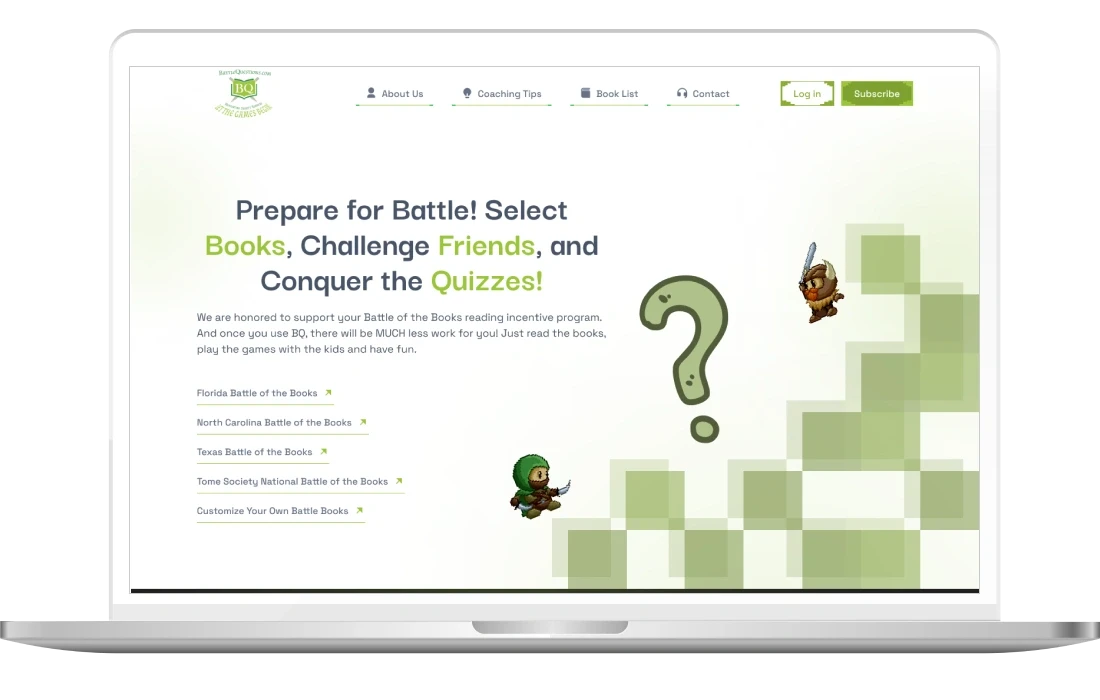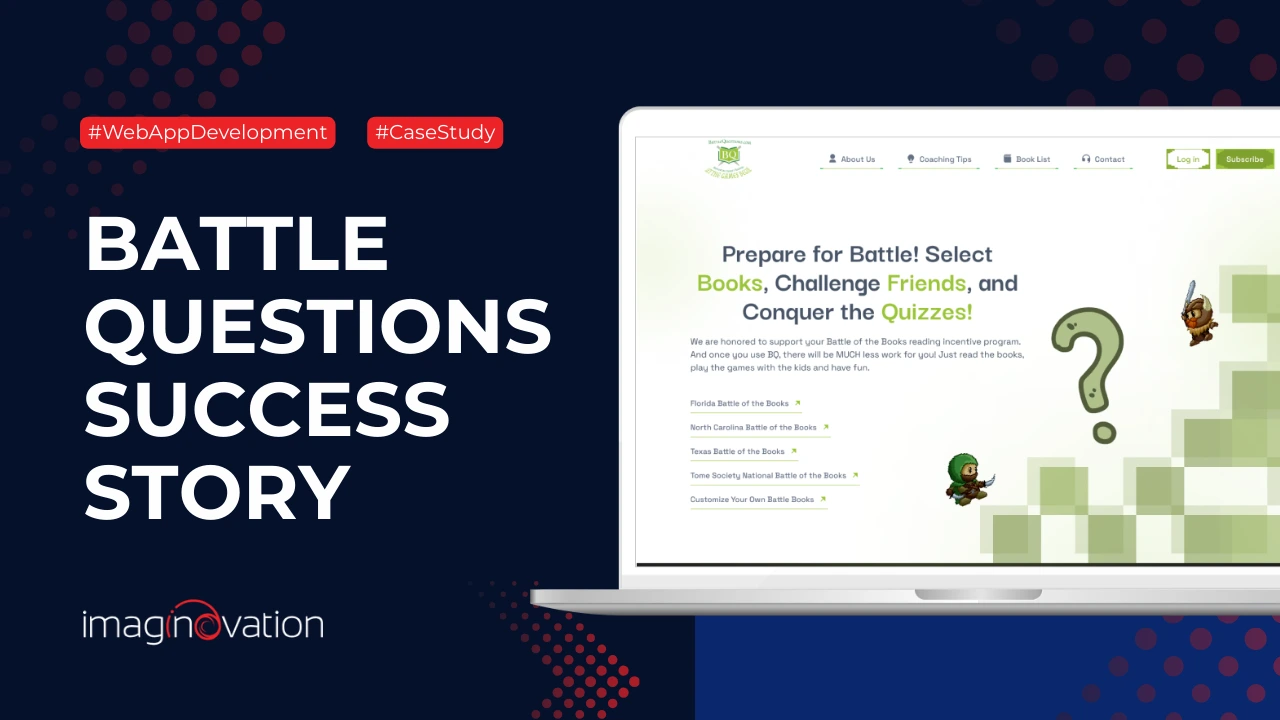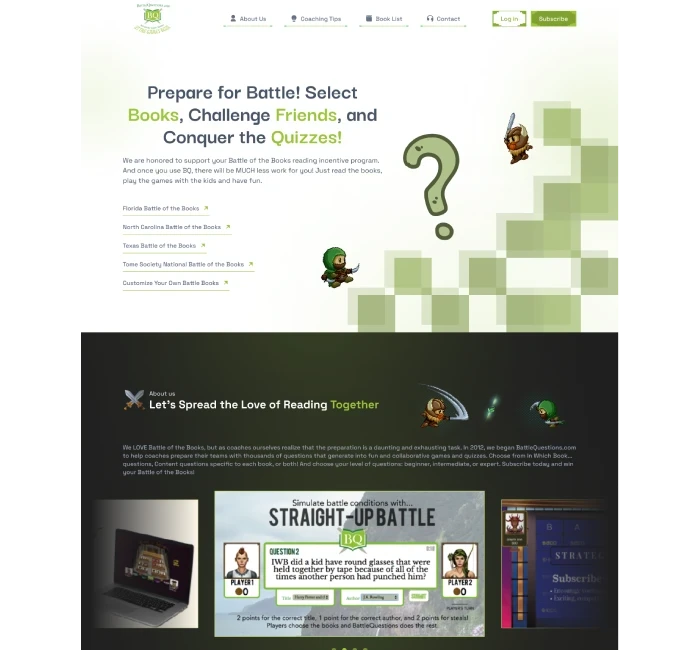About BattleQuestions
BattleQuestions.com is a collaborative platform created by media specialists and teachers to support Battle of the Books coaches. The site offers thousands of questions, an easy-to-use interface, and fun interactive games.
We've enjoyed a great partnership with the BattleQuestions team for the past three years. Recently, they reached out to us to rebuild their website, aiming to make it faster, more modern, and easier to maintain.


The Challenge
The BattleQuestions.com website was becoming hard to maintain due to its outdated and deprecated codebase. We needed to refactor and rebuild it using modern technologies to ensure better sustainability and scalability.
One major challenge was to migrate the existing data from the legacy database to the new system without disrupting the user experience. We aimed to ensure the user interface remained intuitive and familiar, even though the backend architecture was completely overhauled.
The goal was to achieve a seamless transition, maintaining user satisfaction while enhancing the site's performance and maintainability.
Our Strategy
To address the challenges faced by BattleQuestions.com, we implemented a structured, multi-phase approach. Our strategy focused on thorough analysis, careful planning, seamless design, efficient development, rigorous testing, and smooth deployment.
Phase 1
Discovery
We began by thoroughly analyzing the existing BattleQuestions.com website, examining each page, and delving deep into the database structures. This comprehensive review helped us identify key areas that required improvement and modernization.
Phase 2
Planning
With a clear understanding of the requirements, we structured our plan to prioritize backend development. This allowed our UI developers to start their integrations as early as possible, minimizing downtime and ensuring a smooth workflow.
Phase 3
Design
We completed 50% of the design work before beginning development. We secured client approval before moving forward by adhering to the existing game designs and preparing other page designs in Figma. This ensured that our UI development proceeded efficiently and aligned with the client's vision.
Phase 4
Development
We divided the development into two main phases. The first phase focused on completing the foundational elements such as user management, authentication, and roles, excluding the gaming components. As our UI developers integrated these backend elements, we simultaneously began developing the game APIs in parallel. Additionally, we modernized the deployment process by implementing Docker for containerized deployments, ensuring a more streamlined and reliable method.
Phase 5
Testing & Security
Our rigorous testing phase included unit tests at the code level and comprehensive end-to-end testing by a dedicated QA person. This thorough process ensured any issues were identified and addressed before presenting demo versions to the client.
Phase 6
Launch & Maintenance
We deployed the code to a staging environment and shared it with the client for final testing and feedback. We are currently in the final stages of testing and addressing any reported bugs before the official production launch.
Phase 1
Discovery
We began by thoroughly analyzing the existing BattleQuestions.com website, examining each page, and delving deep into the database structures. This comprehensive review helped us identify key areas that required improvement and modernization.
Phase 2
Planning
With a clear understanding of the requirements, we structured our plan to prioritize backend development. This allowed our UI developers to start their integrations as early as possible, minimizing downtime and ensuring a smooth workflow.
Phase 3
Design
We completed 50% of the design work before beginning development. We secured client approval before moving forward by adhering to the existing game designs and preparing other page designs in Figma. This ensured that our UI development proceeded efficiently and aligned with the client's vision.
Phase 4
Development
We divided the development into two main phases. The first phase focused on completing the foundational elements such as user management, authentication, and roles, excluding the gaming components. As our UI developers integrated these backend elements, we simultaneously began developing the game APIs in parallel. Additionally, we modernized the deployment process by implementing Docker for containerized deployments, ensuring a more streamlined and reliable method.
Phase 5
Testing & Security
Our rigorous testing phase included unit tests at the code level and comprehensive end-to-end testing by a dedicated QA person. This thorough process ensured any issues were identified and addressed before presenting demo versions to the client.
Phase 6
Launch & Maintenance
We deployed the code to a staging environment and shared it with the client for final testing and feedback. We are currently in the final stages of testing and addressing any reported bugs before the official production launch.
The Solution
To address the challenges faced by BattleQuestions.com, we completely rebuilt the code base using a modern tech stack. The outdated code had made it difficult for the client to implement changes and resulted in poor performance. Our solution involved redesigning the system to be more efficient and easier to maintain.
By selecting the right technologies and tailoring the system to the client's needs, we ensured that future change requests could be processed quickly and efficiently. The updated platform now performs better, is easier to maintain, and can adapt more readily to new requirements.

The Results
The revamped BattleQuestions.com platform now offers improved performance and is easier to maintain. The modernization efforts have led to a more sustainable and scalable system, enhancing the overall user experience for Battle of the Books coaches and participants.
